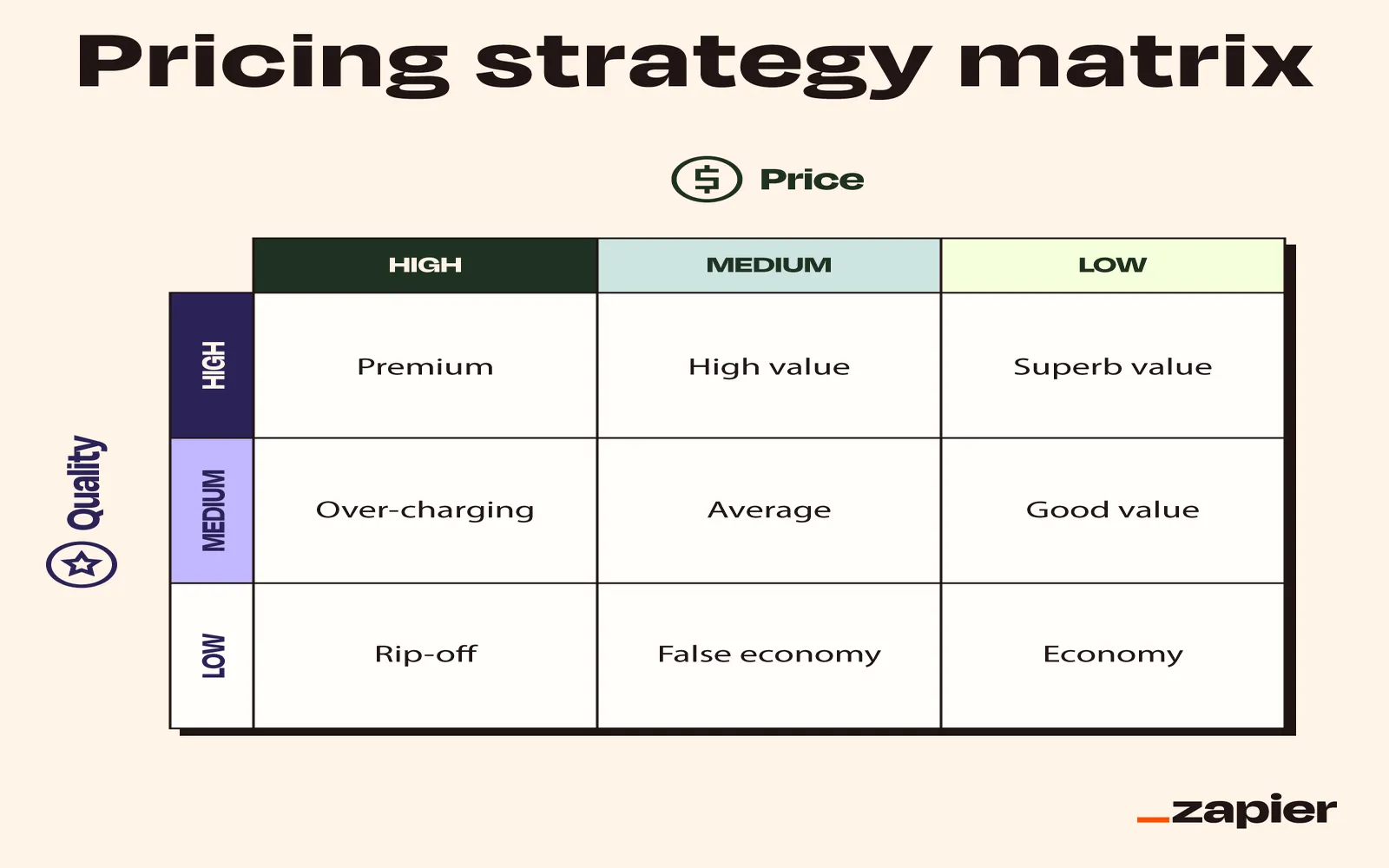
Business growth
Business growth refers to the process of improving a company's success and profitability through various strategies, including expanding market reach, increasing sales, enhancing operational efficiency, and innovating products or services. It involves strategic planning and execution to achieve long-term sustainability and competitiveness in the marketplace.

6 ways businesses are using AI in eCommerce
Businesses are increasingly leveraging AI in eCommerce to enhance customer experiences and streamline operations. Personalized product recommendations based on browsing behavior help increase sales, while chatbots provide 24/7 customer support, improving engagement. AI-driven inventory management optimizes stock levels, reducing costs and preventing shortages. Additionally, dynamic pricing algorithms adjust prices in real time based on market trends and demand. Fraud detection systems enhance security by identifying suspicious activities, and AI analytics offer insights into consumer behavior, enabling data-driven decision-making.

16 pricing strategies and examples (and how to set yours)
This guide explores 16 diverse pricing strategies that businesses can adopt to enhance their market presence and profitability. From cost-plus pricing to value-based pricing and penetration strategies, each approach is illustrated with practical examples to demonstrate its effectiveness. The article also provides insights on how to determine the most suitable pricing strategy for your business by analyzing factors such as target market, competition, and customer perception, helping you to make informed decisions that align with your overall business goals.

The ultimate guide to conducting an IT audit (with checklist)
This comprehensive guide provides a detailed roadmap for conducting an effective IT audit. It outlines essential steps, from defining the audit scope and objectives to assessing risks and evaluating controls. The guide emphasizes the importance of gathering evidence, analyzing data, and reporting findings. Additionally, it includes a practical checklist to ensure all critical areas are covered, such as infrastructure, security policies, and compliance requirements. This resource is invaluable for IT professionals aiming to enhance their organization's security and operational efficiency.

16 books every small business owner should read
A curated selection of essential reading for small business owners, this collection highlights 16 impactful books that offer valuable insights into entrepreneurship, management, marketing, and finance. Each title provides practical strategies, inspiring stories, and expert advice to help navigate the challenges of running a small business. From classic texts to modern bestsellers, these books cover a wide range of topics, empowering owners to enhance their skills, innovate, and ultimately achieve greater success in their ventures.

33 email marketing best practices
Effective email marketing relies on a combination of strategies to engage and convert audiences. Best practices include crafting compelling subject lines to increase open rates, personalizing content for better connection, and segmenting lists to target specific groups. Ensuring mobile optimization is crucial, as many users access emails on their devices. Regularly testing different elements, like CTAs and layouts, helps refine campaigns. Additionally, maintaining compliance with regulations and continuously analyzing performance metrics can significantly enhance overall effectiveness and drive successful outcomes.

SWOT analysis: A how-to guide and template (that won't bore you to tears)
This guide offers a dynamic approach to conducting a SWOT analysis, focusing on strengths, weaknesses, opportunities, and threats. It provides a clear, engaging framework that avoids tedious jargon, making the process accessible and enjoyable. With practical tips and a customizable template, readers can effectively assess their organization or project, uncover insights, and develop strategic plans. The emphasis is on turning analysis into actionable strategies, ensuring that the experience is both informative and inspiring.

What is a RACI chart? And how to make one (with a template)
A RACI chart is a project management tool that clarifies roles and responsibilities within a team. It identifies who is Responsible, Accountable, Consulted, and Informed for each task or deliverable. To create a RACI chart, list tasks along one axis and team members along the other, then fill in the grid with the appropriate RACI designations. This visual representation helps ensure everyone understands their roles, promotes accountability, and enhances communication, ultimately leading to more efficient project execution. Templates are widely available for easy customization.

61 best businesses to start with $10K or less
Starting a business with a budget of $10,000 or less is entirely feasible and can lead to successful ventures. Various options cater to different interests and skills, from online services like digital marketing and e-commerce to local offerings such as cleaning services or food trucks. These businesses often require minimal overhead and can be launched quickly, allowing entrepreneurs to test their ideas with lower financial risk. With creativity and determination, aspiring business owners can turn a modest investment into a thriving enterprise.

14 data visualization examples to captivate your audience
Discover a range of compelling data visualization examples designed to engage and captivate your audience. From interactive dashboards to infographics, these visual tools effectively convey complex information in an accessible manner. By employing diverse techniques such as heat maps, scatter plots, and animated charts, you can enhance storytelling and drive insights. Each example showcases the power of visual representation in transforming data into impactful narratives that resonate with viewers, ultimately fostering better understanding and retention of information.

Project milestones for improved project management
Project milestones are key checkpoints that help track progress and ensure effective project management. These significant events mark the completion of critical phases and deliverables, enabling teams to assess performance against timelines and objectives. By establishing clear milestones, project managers can enhance communication, foster accountability, and identify potential risks early in the process. This structured approach not only keeps the project on schedule but also motivates team members by celebrating achievements and maintaining momentum throughout the project's lifecycle.

What is data analysis? Examples and how to get started
Data analysis involves examining, cleaning, and interpreting data to uncover meaningful insights and inform decision-making. It encompasses various techniques, such as statistical analysis and data visualization, to identify trends, patterns, and correlations. Examples include analyzing sales data to improve marketing strategies or studying customer feedback to enhance product offerings. To get started, one can learn programming languages like Python or R, explore data analysis tools like Excel or Tableau, and practice with real datasets available online to build skills and experience.

A step-by-step guide to competitive market analysis
A step-by-step guide to competitive market analysis provides a structured approach for businesses to evaluate their competitive landscape. It begins by identifying key competitors and gathering relevant data on their products, pricing, and marketing strategies. Next, it involves analyzing market trends and customer preferences to uncover opportunities and threats. By assessing strengths and weaknesses, businesses can position themselves effectively. This comprehensive analysis ultimately aids in informed decision-making, helping organizations refine their strategies to gain a competitive advantage.

The 5 sales forecasting spreadsheets you really need
Sales forecasting spreadsheets are essential tools for businesses aiming to predict future sales accurately. Key templates include a basic sales forecast, which offers a straightforward overview of expected revenue; a detailed pipeline forecast, ideal for tracking leads through the sales process; a seasonal sales forecast to account for fluctuations; a revenue projection spreadsheet for long-term planning; and a sales team performance tracker to evaluate individual contributions. Together, these spreadsheets provide a comprehensive approach to effective sales planning and strategy.

12 examples of corporate social responsibility done right
This piece highlights twelve exemplary instances of corporate social responsibility (CSR) where companies have effectively integrated ethical practices into their operations. From sustainable sourcing and community engagement to innovative environmental initiatives, these examples demonstrate how businesses can positively impact society while enhancing their brand reputation. Each case illustrates a commitment to social and environmental stewardship, showcasing the potential for corporations to contribute meaningfully to global challenges and foster a culture of responsibility that resonates with consumers and stakeholders alike.

How AI project management can boost productivity
AI project management enhances productivity by automating routine tasks, streamlining workflows, and providing data-driven insights. It helps teams prioritize assignments, allocate resources efficiently, and forecast project outcomes with greater accuracy. By analyzing project data in real-time, AI identifies potential bottlenecks and recommends solutions, allowing teams to stay focused on their goals. This technology fosters improved collaboration and communication, enabling team members to work more effectively together, ultimately leading to faster project completion and higher quality results.

18 one-pager examples and templates
This resource offers a collection of 18 one-pager examples and templates designed to help individuals and organizations effectively communicate their ideas, projects, or products in a concise format. Each example showcases different styles and layouts, catering to various purposes such as business proposals, marketing plans, or educational summaries. The templates are user-friendly and adaptable, allowing users to customize content while maintaining a professional appearance. This guide serves as a valuable tool for anyone looking to enhance their presentation skills and clarity in communication.

What is a two-sided marketplace?
A two-sided marketplace is a platform that connects two distinct user groups, typically buyers and sellers, facilitating transactions between them. This model thrives on network effects, where the value of the platform increases as more participants join. Examples include e-commerce sites, ride-sharing apps, and accommodation services. By providing tools and resources for both sides, the marketplace enables efficient interactions, enhances user experience, and often generates revenue through fees or commissions on transactions.

Low-code vs. no-code: Understanding the key differences and benefits
Low-code and no-code platforms are both designed to simplify application development, but they cater to different user needs. Low-code platforms allow developers to build applications with minimal coding, providing flexibility for customization and integration. In contrast, no-code platforms enable users without programming expertise to create applications using visual interfaces and pre-built components. Both approaches offer significant benefits, including faster development times, reduced costs, and increased accessibility, empowering organizations to innovate and respond quickly to changing market demands.

Story points in Agile: What they are and how to use them
Story points are a unit of measure used in Agile methodologies to estimate the relative effort required to complete a user story or task. Instead of focusing on time, story points account for complexity, risks, and uncertainties involved in the work. Teams assign points based on consensus during planning sessions, fostering collaboration and understanding. By using story points, teams can prioritize work, track progress, and improve their planning accuracy over time, ultimately enhancing their efficiency and delivery in Agile projects.

What is email segmentation? 13 strategies to get started
Email segmentation is the practice of dividing an email list into specific groups based on various criteria, such as demographics, behavior, or purchase history. This targeted approach allows marketers to send personalized content that resonates with each segment, improving engagement and conversion rates. The article outlines 13 effective strategies to implement segmentation, including utilizing customer data, creating buyer personas, and analyzing engagement metrics. By adopting these strategies, businesses can enhance their email marketing efforts and foster stronger relationships with their audience.